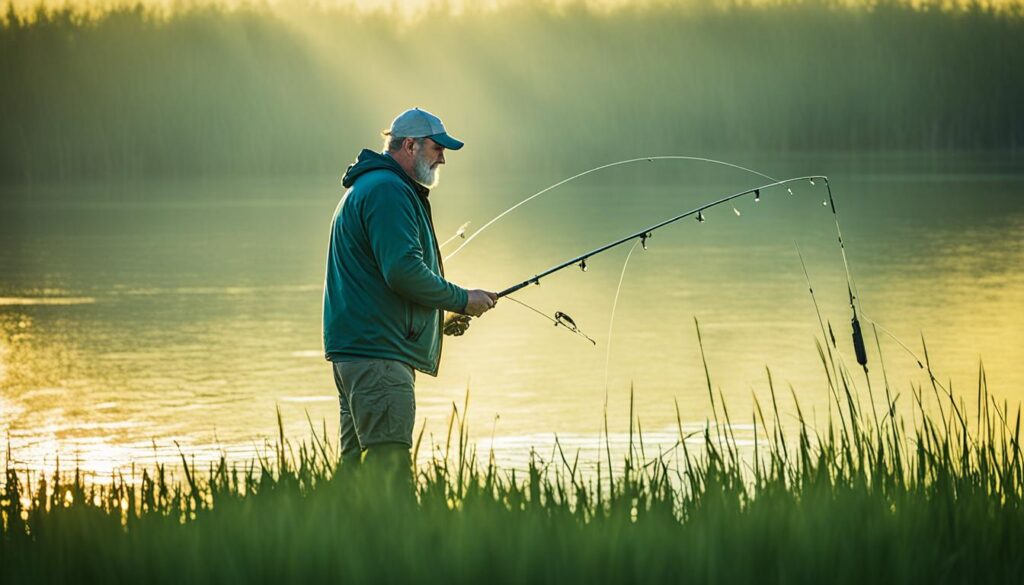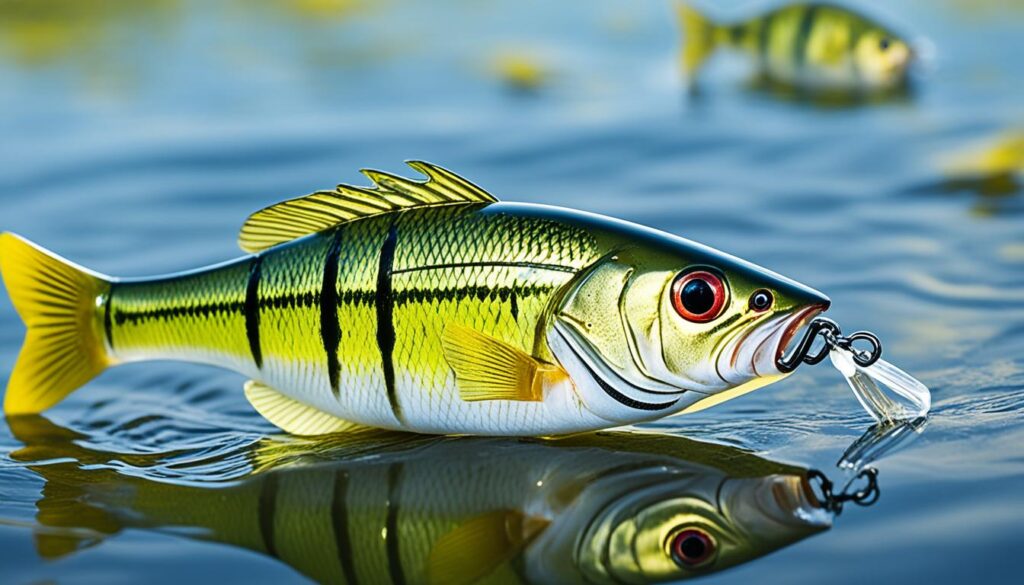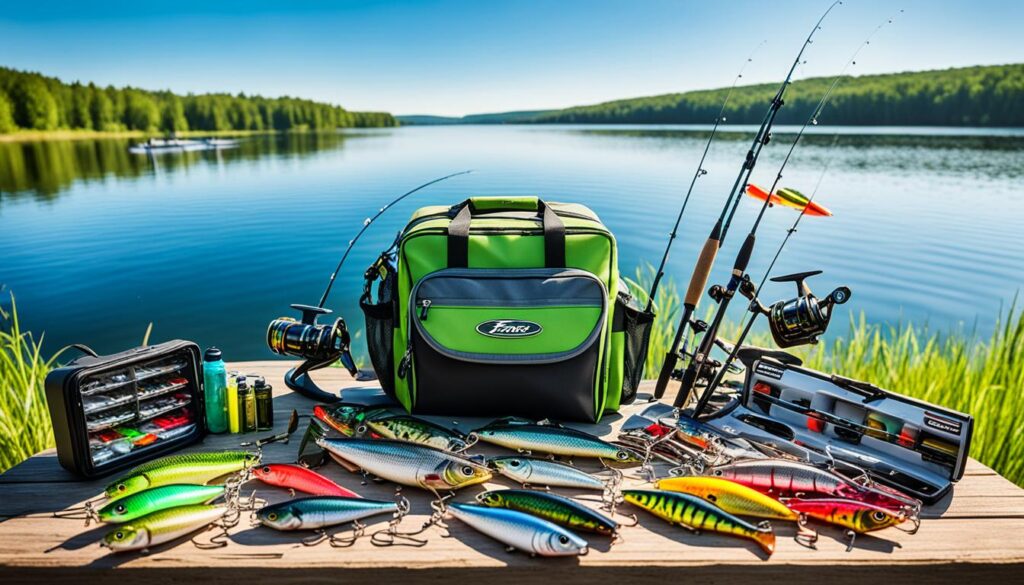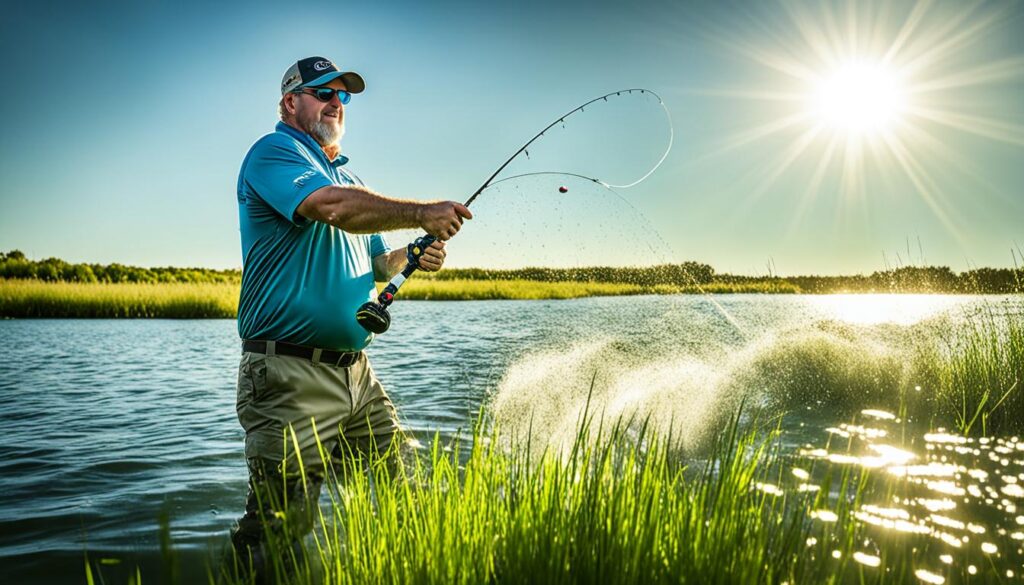Are you ready to enhance your bass fishing techniques and catch more fish this summer? Look no further – Ihave three of the best grass crankbait tricks to help you hook those elusive summer bass. When it comes to bass fishing, using the proper techniques and lures can make all the difference in your success. Let’s explore these tricks that fishing experts swear by!
Angler’s Essentials
- Using crankbaits as a search bait can help you locate bass in grass lakes.
- Opt for buoyant crankbaits made of balsa wood to successfully navigate through weed-choked areas.
- Making shorter casts provides better depth control and reduces the chances of getting tangled in weeds.
- Deep-diving crankbaits are ideal for triggering bites from offshore bass during the summer months.
- Choosing bright colors for deep diving crankbaits can attract the attention of fish and increase your chances of success.
Use Crankbaits as a Search Bait on Grass Lakes
When fishing in grass lakes, it’s important to have effective strategies for locating bass. Many grass lakes have heavy weed growth in shallow and mid-depth areas, causing bass to spread out during the summer months. One highly efficient technique is using crankbaits as a search bait.
Unlike other baits, crankbaits excel at covering a lot of water quickly. They can be fished fast and have fish-triggering qualities that entice bass to strike. The buoyant nature of crankbaits allows them to stay in the water column where active bass often feed, making them perfect for exploring grass lakes.
By using crankbaits as a search bait, anglers can effectively cover large areas of grass lakes to find bass. The fast retrieval speed and fish-attracting action of crankbaits help draw strikes from lurking bass, even in heavily weeded areas.
When fishing with crankbaits as a search bait, it’s essential to cast and retrieve in a methodical manner. Exploring different depths, speeds, and directions can help identify the best locations and trigger aggressive strikes from bass.
Using crankbaits as a search bait allows me to efficiently explore grass lakes and locate scattered bass. The fast action and fish-attracting qualities make crankbaits a reliable choice for covering large areas and finding active fish.
Key Benefits of Using Crankbaits as a Search Bait:
- Efficiently cover large areas of grass lakes
- Fish-triggering action attracts bass even in weedy areas
- Stay in the water column where active bass feed
- Help identify the best locations for bass
So, if you’re fishing in a grass lake and want to locate bass quickly, don’t forget to tie on a crankbait and use it as a search bait. Its fast action, fish-triggering qualities, and ability to stay in the water column make it a valuable tool for bass anglers.
Choose a Buoyant Crankbait for Grass Lakes
When fishing in grass lakes, choosing a buoyant crankbait made of balsa wood is essential. The bait’s buoyancy allows it to tick the top of the weeds without getting tangled. Balsa crankbaits float faster than plastic ones, reducing the chances of getting stuck in the grass and varying the retrieve when the bait contacts grass can help it float up and straightforward the weeds, reducing fowling.
| Advantages | Disadvantages |
|---|---|
| Floats faster | May be more expensive |
| Clears weeds effectively | Requires sensitive rod and reel |
| Less chance of tangles | May not have as much depth control |
To illustrate the difference in buoyancy between balsa and plastic crankbaits, consider the following comparison:
“I have often found that using a buoyant crankbait in grass lakes significantly improves weed clearance. The balsa wood construction allows the bait to float faster, preventing it from getting stuck in the dense vegetation. I’ve experienced fewer tangles and more successful retrieves using buoyant crankbaits in these conditions.”
Make Shorter Casts in Grass Lakes

Contrary to conventional crankbait fishing wisdom, shorter casts are more effective in grass lakes. When casting long distances, there is a higher chance of snagging weeds at the end, wasting precious opportunities to catch bass. Therefore, opting for shorter to mid-range casts provides better depth control of the bait and greatly reduces the chances of getting entangled in the grass.
By manipulating the rod angle, anglers can maintain better control of the bait throughout the retrieve. This increased control allows for precise presentation and enhances the chances of enticing a strike from bass hiding within the grassy areas of the lake. Keeping the casts short also preserves valuable fishing time by minimizing the need to retrieve the bait through dense vegetation.
In grass lakes, where bass tend to seek shelter amidst the vegetation, adopting a strategy of shorter casts can lead to more successful and productive fishing outings. The ability to accurately control the depth and movement of the bait in these dense areas increases the likelihood of enticing strikes and landing trophy-worthy catches.
Deep-Diving Crankbaits for Offshore Bass
When it comes to summer fishing, targeting offshore bass can be a rewarding challenge. Deep-diving crankbaits are a go-to lure for this type of fishing, as they excel at finding and triggering bass in deeper water. By understanding their effectiveness and employing the right techniques, you can increase your chances of success.
Deep-diving crankbaits:
- Designed to reach greater depths and cover more water
- Equipped with a large lip that enables them to dive down
- Imitate baitfish and create vibrations to attract bass
These lures are particularly effective when fishing around deeper main lake points, deep shoreline edges, and offshore humps. To make the most of your deep-diving crankbait, it’s essential to position your boat downwind of the fish. This prevents spooking and allows for accurate casts. Remember, precision is key when targeting offshore bass.
Another technique that can trigger bites from bass is changing up the retrieve speed and direction. By varying your retrieve, you can imitate the erratic movements of injured or fleeing baitfish, enticing bass to strike. Experiment with different speeds, pauses, and twitches to find the retrieve that works best for the conditions and the bass’s feeding behavior.
Using a deep-diving crankbait requires a robust and sensitive rod and reel combo. A medium-heavy to heavy power rod with moderate to fast action is ideal for handling the resistance and fight of offshore bass. Pair it with a high-speed baitcasting reel to quickly retrieve the lure and maintain control.
To give you a better understanding of the effectiveness of deep-diving crankbaits, here’s a table summarizing their advantages and best fishing scenarios:
| Advantages of Deep-Diving Crankbaits | Best Fishing Scenarios |
|---|---|
| Dive to greater depths | Deeper main lake points |
| Attract bass with vibrations | Deep shoreline edges |
| Mimic baitfish movements | Offshore humps |
Remember, when using deep-diving crankbaits, it’s crucial to consider the bass’s location, movement patterns, and preferred prey. By utilizing these lures effectively, you can target offshore bass during the summer months and enhance your fishing experience.
Stay tuned for the next section, where I’ll discuss the use of bright colors for deep crankbaits and how they attract the attention of fish in different environments.
Choose Bright Colors for Deep Crankbaits
When it comes to deep crankbaits, choosing the right colors plays a critical role in attracting the attention of fish. Bright colors can be highly effective in getting the fish to strike. By matching the bait color to the predominant forage in the area, and then opting for bright and bold colors, you can significantly increase your chances of success.
For example, on bluegill lakes, using chartreuse and yellow combinations can trigger aggressive bass. The vibrant shades mimic the colors of the bluegill’s fins, triggering a predatory response. On shad fisheries, white or pearl-colored crankbaits can be highly effective in imitating the appearance of the shad, a popular forage for bass.
In addition to color selection, it’s important to incorporate speed and direction changes into your retrieve. This maneuverability combined with the bright colors will catch the attention of fish and provoke an instinctive reaction. The key is to make your crankbait stand out in the water and create the illusion of an easy meal.
To further enhance your understanding of color preferences, below is a table highlighting recommended color options for different scenarios:
| Scenario | Recommended Bright Colors |
|---|---|
| Bluegill Lakes | Chartreuse and yellow combinations |
| Shad Fisheries | White or pearl varieties |
Shallow Squarebill Crankbaits for Late Summer

In late summer, I have found that using shallow squarebill crankbaits can be incredibly effective for covering water quickly and enticing aggressive reaction strikes. These versatile lures are perfect for targeting bass in various situations, particularly when fishing in grassy areas and near hard cover. By adjusting my approach based on factors such as water depth and the fish’s aggression level, I have been able to maximize my success with these crankbaits.
Finding Success in Grass Lanes and Near Grass Flats
When using shallow squarebill crankbaits in late summer, I have had great success by focusing on targeting lanes in the grass and the first areas of hard cover near grass flats. These are prime spots where bass often hide and ambush their prey. By accurately casting my bait into these areas and retrieving it with a steady, erratic motion, I have been able to trigger aggressive strikes from bass that couldn’t resist the temptation.
Adapting to Water Depth and Fish Aggression
One of the key considerations when using shallow squarebill crankbaits is selecting the appropriate bait for the specific fishing conditions. Depending on the depth of the water and the aggression level of the fish, I choose a crankbait that runs at the desired depth. This allows me to effectively target fish at different water columns and increase my chances of getting more strikes. Additionally, I adjust my retrieval speed and rhythm to match the mood of the fish and trigger reaction strikes.
Targeting Deep Transitions and Channel Bends
While shallow squarebill crankbaits are primarily known for their effectiveness in shallow water, I have also found success using them in deeper areas near the edges of grass flats, channel bends, and humps. These areas often hold bass that are seeking slightly deeper waters. By targeting these transitions and casting my crankbait with precision, I have been able to entice strikes from fish that are lurking in these prime locations.
In summary, shallow squarebill crankbaits have proven to be highly effective lures for late summer fishing. By focusing on grass lanes, targeting the first areas of hard cover near grass flats, adapting to water depth and fish aggression, and exploring transitional areas, anglers can increase their chances of drawing aggressive reaction strikes and having a successful fishing outing.
Recommended Gear for Crankbait Fishing

Regarding crankbait fishing, having the right gear is essential for optimal performance and success on the water. Whether you’re using deep diving crankbaits or shallow squarebill crankbaits, choosing the appropriate equipment can significantly impact your fishing experience. Here are my recommendations for crankbait fishing gear:
Deep Diving Crankbaits:
For deep diving crankbaits, I suggest using a 7’4″ MH/moderate fast rod paired with a high-speed casting reel. This combination provides the necessary strength and sensitivity for handling larger crankbaits and detecting subtle strikes. Additionally, a 14-pound fluorocarbon line is ideal for ripping the lure free from grass and fighting bass effectively.
Shallow Squarebill Crankbaits:
When fishing with shallow squarebill crankbaits, a 7’2″ medium rod with a medium gear ratio reel is the way to go. This setup allows for precise casts and better control over the bait’s movement in shallow water. I recommend using a 12-pound fluorocarbon line, which provides sufficient strength while maintaining the bait’s natural action.
Remember, the right gear can enhance your crankbait fishing experience and improve your chances of landing more bass. By selecting the appropriate rod, reel, and line for each type of crankbait, you’ll be well-equipped for success on the water.
| Recommended Gear | Deep Diving Crankbaits | Shallow Squarebill Crankbaits |
|---|---|---|
| Rod | 7’4″ MH/moderate fast rod | 7’2″ medium rod |
| Reel | High-speed casting reel | Medium gear ratio reel |
| Line | 14-pound fluorocarbon | 12-pound fluorocarbon |
Conclusion
Incorporating these three grass crankbait tricks into your summer bass fishing strategy can greatly increase your chances of success. By using crankbaits as a search bait, you can efficiently locate bass in grass lakes. Choosing buoyant options allows your bait to clear weeds and stay in the strike zone. Making shorter casts helps you maintain better control of the bait and avoid getting snagged in the weeds.
Deep-diving crankbaits and shallow squarebill crankbaits are both effective in different fishing scenarios. Deep-diving crankbaits are ideal for finding and triggering offshore bass, while shallow squarebill crankbaits are great for drawing aggressive reaction strikes in shallow water. Experiment with different colors and retrieve techniques to increase your chances of attracting bass.
Pairing the right gear with the proper techniques is crucial for a successful summer bass fishing season. Use a 7’4″ MH/moderate fast rod and high-speed casting reel for deep diving crankbaits, and a 7’2″ medium rod with a medium gear ratio reel for shallow squarebill crankbaits. Don’t forget to use the appropriate fluorocarbon line for the specific fishing scenario.
With these grass crankbait tricks and the right gear, you’ll be well-equipped to tackle summer bass fishing and increase your chances of success. Happy fishing!
FAQ
What are some grass crankbait tricks for catching summer bass?
Here are three grass crankbait tricks recommended by fishing experts to help you catch more bass:
How can crankbaits be used as a search bait on grass lakes?
Crankbaits can be fished fast and have fish-triggering qualities, making them an efficient way to locate fish in grass lakes.
Why is it important to choose a buoyant crankbait for grass lakes?
Buoyant crankbaits made of balsa wood can tick the top of weeds without getting tangled, reducing the chances of getting stuck in the grass.
Why are shorter casts more effective in grass lakes?
Long casts often result in snagging weeds, so shorter casts provide better depth control of the bait and reduce the chances of fowling.
How can deep-diving crankbaits be effective for offshore bass during the summer?
Deep-diving crankbaits are excellent lures for finding and triggering offshore bass. They are effective around deeper main lake points, deep shoreline edges, and offshore humps.
Why should bright colors be chosen for deep diving crankbaits?
Choosing bright colors for deep diving crankbaits can help get the attention of fish and trigger aggressive bass. Matching the bait color to the predominant forage and using bright and bold colors can be highly effective.
Are shallow squarebill crankbaits effective for late summer fishing?
Yes, shallow squarebill crankbaits are highly effective for covering water quickly and drawing aggressive reaction strikes in late summer. Focusing on lanes in the grass and the first hard cover near grass flats can yield great results.
What gear is recommended for crankbait fishing?
For deep diving crankbaits, a 7’4″ MH/moderate fast rod paired with a high-speed casting reel and 14-pound fluorocarbon line is recommended. For shallow squarebill crankbaits, a 7’2″ medium rod with a medium gear ratio reel and 12-pound fluorocarbon line is suitable.
How can incorporating these grass crankbait tricks increase summer bass fishing success?
Incorporating these grass crankbait tricks into your summer bass fishing strategy can greatly increase your chances of success. Using crankbaits as a search bait, choosing buoyant options, and making shorter casts in grass lakes can help you locate and catch more bass. Deep-diving crankbaits and shallow squarebill crankbaits are effective for different fishing scenarios. Pairing the right gear with the right techniques can lead to a successful summer bass fishing season.
